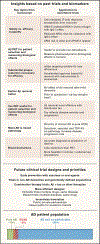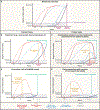Accelerating Alzheimer's therapeutic development: The past and future of clinical trials
- PMID: 37848035
- PMCID: PMC10625460
- DOI: 10.1016/j.cell.2023.09.023
Accelerating Alzheimer's therapeutic development: The past and future of clinical trials
Abstract
Alzheimer's disease (AD) research has entered a new era with the recent positive phase 3 clinical trials of the anti-Aβ antibodies lecanemab and donanemab. Why did it take 30 years to achieve these successes? Developing potent therapies for reducing fibrillar amyloid was key, as was selection of patients at relatively early stages of disease. Biomarkers of the target pathologies, including amyloid and tau PET, and insights from past trials were also critical to the recent successes. Moving forward, the challenge will be to develop more efficacious therapies with greater efficiency. Novel trial designs, including combination therapies and umbrella and basket protocols, will accelerate clinical development. Better diversity and inclusivity of trial participants are needed, and blood-based biomarkers may help to improve access for medically underserved groups. Incentivizing innovation in both academia and industry through public-private partnerships, collaborative mechanisms, and the creation of new career paths will be critical to build momentum in these exciting times.
Copyright © 2023 University of California, San Francisco. Published by Elsevier Inc. All rights reserved.
Conflict of interest statement
Declaration of interests Adam Boxer has served as a consultant to AGTC, Alector, Alzprotect, Amylyx, Arkuda, Arrowhead, Arvinas, Aviado, Boehringer Ingelheim, Denali, Eli Lilly, GSK, Humana, Life Edit, Merck, Modalis, Oligomerix, Oscotec, Roche, Transposon and Wave. He has received research support from Biogen and Eisai for serving as a site investigator for clinical trials, as well as from Regeneron. He has received research support from the National Institutes on Aging: NIH U19AG063911, R01AG073482, R56AG075744, R01AG038791, RF1AG077557, R01AG071756, U24AG057437; Rainwater Charitable Foundation, Bluefield Project to Cure FTD, GHR Foundation, Alzheimer’s Association, Association for Frontotemporal Degeneration, Gates Ventures, Alzheimer’s Drug Discovery Foundation, UCSF Parkinson’s Spectrum Disorders Center and the University of California Cures AD Program. Reisa Sperling has served as a consultant to AC Immune, Acumen, Alector, Bristol Myers Squibb, Genentech, Ionis, Janssen, Oligomerix, Prothena, Roche, Shionogi and Vaxxinity. Her spouse has been a consultant to Merck and Novartis. She has received research funding from the National Institute on Aging, NIH: P01AG036694, U24AG057437; R01AG063689; R01AG054029; R01AG061848; Alzheimer’s Association, GHR Foundation, Gates Ventures, an Anonymous Foundation, Accelerating Medicines Partnership FNIH, and public partnership trial funding from Eli Lilly, and Eisai.
Figures




References
Publication types
MeSH terms
Substances
Grants and funding
- RF1 AG077557/AG/NIA NIH HHS/United States
- R01 AG063689/AG/NIA NIH HHS/United States
- R01 AG054029/AG/NIA NIH HHS/United States
- U24 AG057437/AG/NIA NIH HHS/United States
- U19 AG063911/AG/NIA NIH HHS/United States
- R56 AG075744/AG/NIA NIH HHS/United States
- P01 AG019724/AG/NIA NIH HHS/United States
- R01 AG061848/AG/NIA NIH HHS/United States
- R01 AG071756/AG/NIA NIH HHS/United States
- R01 AG073482/AG/NIA NIH HHS/United States
- P01 AG036694/AG/NIA NIH HHS/United States
- R01 AG078457/AG/NIA NIH HHS/United States
- R01 AG038791/AG/NIA NIH HHS/United States
LinkOut - more resources
Full Text Sources
Other Literature Sources
Medical
Miscellaneous

